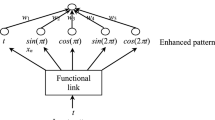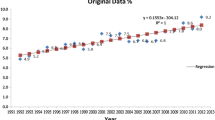Abstract
Prediction of energy consumption for a country (region) plays critical roles in economy and energy security, and accurate energy consumption forecasting is valuable for policy makers to formulate energy policies. To do this, we propose a novel improved GM(1,1) model, which is based on both data transformation for the original data sequence and optimization of the background value, and is therefore named as TBGM(1,1). TBGM(1,1) is employed to predict the total energy consumption of Shanghai City in China. And the results suggest that the TBGM(1,1) performs well compared with the traditional GM(1,1) model and other grey modification models in this context and Shanghai’s total energy consumption will increase stably in the following five years. In summary TBGM(1,1) proposed in our study has competent exploration and exploitation ability, and TBGM(1,1) could be utilized as an effective and promising tool for short-term planning, which can be applied for energy consumption forecasting in particular and for other forecasting issues as well.



Similar content being viewed by others
References
Pi, D., Liu, J., Qin, X.: A Grey prediction approach to forecasting energy demand in China. Energy Source Part A 32, 1517–1528 (2010)
Delgado-Gomes, V., Oliveira-Lima, J.A., Martins, J.F.: Energy consumption awareness in manufacturing and production systems. Int. J. Comput. Integr. Manuf. 30, 84–95 (2017)
Mouzon, G., Yildirim, M.B., Twomey, J.: Operational methods for minimization of energy consumption of manufacturing equipment. Int. J. Prod. Res. 45, 4247–4271 (2007)
Ali, A., Abo-Zahhad, M., Farrag, M.: Modeling of wireless sensor networks with minimum energy consumption. Arab. J. Sci. Eng. 42, 2631–2639 (2017)
Zhao, L., Liang, R., Zhang, J., et al.: A new method for building energy consumption statistics evaluation: ratio of real energy consumption expense to energy consumption. Energy Syst. 5, 627–642 (2014)
Suganthi, L., Samuel, A.A.: Energy models for demand forecasting—a review. Renew. Sustain. Energy Rev. 16, 1223–1240 (2012)
Salisu, A.A., Ayinde, T.O.: Modeling energy demand: some emerging issues. Renew. Sustain. Energy Rev. 54, 1470–1480 (2016)
Khadgi, P., Bai, L., Evans, G., et al.: A simulation model with multi-attribute utility functions for energy consumption scheduling in a smart grid. Energy Syst. 6, 533–550 (2015)
Lin, B., Liu, W.: Scenario prediction of energy consumption and \(CO_2\) emissions in China’s machinery industry. Sustainability 9, 87 (2017)
Xu, J.H., Fleiter, T., Eichhammer, W., Fan, Y.: Energy consumption and \(CO_2\) emissions in China’s cement industry: a perspective from LMDI decomposition analysis. Energy Policy 50, 821–832 (2012)
Zhang, X.P., Cheng, X.M.: Energy consumption, carbon emissions, and economic growth in China. Ecol. Econ. 68, 2706–2712 (2009)
Soytas, U., RSari, R., Ewing, B.T.: Energy consumption, income, and carbon emissions in the United States. Ecol. Econ. 63, 482–489 (2007)
Alghandoor, A., Phelan, P.E., Villalobos, R., Phelan, B.E.: US manufacturing aggregate energy intensity decomposition: the application of multivariate regression analysis. Int. J. Energy Res. 32, 91–106 (2008)
Ediger, V.S., Akar, S.: ARIMA forecasting of primary energy demand by fuel in Turkey. Energy Policy 35, 1701–1708 (2007)
Wesseh, P.K., Zoumara, B.: Causal independence between energy consumption and economic growth in Liberia: evidence from a non-parametric bootstrapped causality test. Energy Policy 50, 518–527 (2012)
Cheong, C.W.: Parametric and non-parametric approaches in evaluating martingale hypothesis of energy spot markets. Math. Comput. Model. 54, 1499–1509 (2011)
Li, J., Wang, R., Wang, J., Li, Y.: Analysis and forecasting of the oil consumption in China based on combination models optimized by artificial intelligence algorithms. Energy. 144, 243–264 (2018)
Lee, Y.S., Tong, L.I.: Forecasting energy consumption using a Grey model improved by incorporating genetic programming. Energy Convers. Manag. 52, 147–152 (2011)
Karimi, H., Dastranj, J.: Artificial neural network-based genetic algorithm to predict natural gas consumption. Energy Syst. 5, 571–581 (2014)
Rumbayan, M., Abudureyimu, A., Nagasaka, K.: Mapping of solar energy potential in Indonesia using artificial neural network and geographical information system. Renew. Sustain. Energy Rev. 16, 1437–1449 (2012)
Gürbüz, F., Öztürk, C., Pardalos, P.: Prediction of electricity energy consumption of Turkey via artificial bee colony: a case study. Energy Syst. 4, 289–300 (2013)
Wang, X., Luo, D., Zhao, X., Sun, Z.: Estimates of energy consumption in China using a self-adaptive multi-verse optimizer-based support vector machine with rolling cross-validation. Energy 152, 539–548 (2018)
Ding, S., Hipel, K.W., Dang, Y.G.: Forecasting China’s electricity consumption using a new Grey prediction model. Energy 149, 314–328 (2018)
Chung, Y.H.: Electricity consumption prediction using a neural-network-based Grey forecasting approach. J. Oper. Res. Soc. 68, 1259–1264 (2017)
Feng, S.J., Ma, Y.D., Song, Z.l, Ying, J.: Forecasting the energy consumption of China by the Grey prediction model. Energy Sources Part B Econ. Plan. Policy 7, 376–389 (2012)
Kumar, U., Jain, V.K.: Time series models (Grey–Markov, Grey Model with rolling mechanism and singular spectrum analysis) to forecast energy consumption in India. Energy 35, 1709–1716 (2010)
Deng, J.L.: Control problem of Grey systems. Syst. Control Lett. 5, 288–294 (1982)
Li, G.D., Masuda, M., Nagai, M.: The prediction for Japan’s domestic and overseas automobile production. Technol. Forecast. Soc. Change. 87, 224–231 (2014)
Tabaszewski, M., Cempel, C.: Using a set of GM(1,1) models to predict values of diagnostic symptoms. Mech. Syst. Signal Process. 52–53, 416–425 (2015)
Deng, J.L.: Introduction to Grey system theory. J. Grey Syst. 1, 1–24 (1989)
Lee, Y.C., Wu, C.H., Tsai, S.B.: Grey system theory and fuzzy time series forecasting for the growth of green electronic materials. Int. J. Prod. Res. 52, 2931–2945 (2014)
Li, G.D., Masuda, M., Nagai, M.: Predictor design using an improved Grey model in control systems. Int. J. Comput. Integr. Manuf. 28, 297–306 (2015)
Tang, H.W.V., Yin, M.S.: Forecasting performance of Grey prediction for education expenditure and school enrollment. Econ. Educ. Rev. 31, 452–462 (2012)
Li, H., Xiao, T.: Improved generalized energy index method for comprehensive evaluation and prediction of track irregularity. J. Stat. Comput. Simul. 84, 1213–1231 (2014)
Wang, J., Jiang, H.Y., Zhou, Q.P., Wu, J., Qin, S.S.: China’s natural gas production and consumption analysis based on the multicycle Hubbert model and rolling Grey model. Renew. Sustain. Energy Rev. 53, 1149–1167 (2016)
Akay, D., Atak, M.: Grey prediction with rolling mechanism for electricity demand forecasting of Turkey. Energy 32, 1670–1675 (2007)
Zhao, H., Guo, S.: An optimized Grey model for annual power load forecasting. Energy 107, 272–286 (2016)
Wang, Z.X., Hao, P.: An improved Grey multivariable model for predicting industrial energy consumption in China. Appl. Math. Model. 40, 5745–5758 (2016)
Ma, X., Hu, Y.S., Liu, Z.B.: A novel kernel regularized nonhomogeneous Grey model and its applications. Commun. Nonlinear Sci. Numer. Simul. 48, 51–62 (2017)
Mao, S., Gao, M., Xiao, X., Zhu, M.: A novel fractional Grey system model and its application. Appl. Math. Model. 40, 5063–5076 (2016)
Wu, L., Liu, S., Yao, L., Yan, S.: The effect of sample size on the Grey system model. Appl. Math. Model. 37, 6577–6583 (2013)
Hu, Y.C., Jiang, P.: Forecasting energy demand using neural-network-based Grey residual modification models. J. Oper. Res. Soc. 68, 556–565 (2017)
Li, K., Liu, L., Zhai, J., et al.: The improved Grey model based on particle swarm optimization algorithm for time series prediction. Eng. Appl. Artif. Intell. 55, 285–291 (2016)
Li, D.C., Chang, C.J., Chen, C.C., Chen, W.C.: Forecasting short-term electricity consumption using the adaptive Grey-based approach—an Asian case. Omega 40, 767–773 (2012)
Wang, Y., Liu, Q., Tang, J., et al.: Optimization approach of background value and initial item for improving prediction precision of GM(1,1) model. J. Syst. Eng. Electron. 25, 77–82 (2014)
Tien, T.L.: A new Grey prediction model FGM(1,1). Math. Comput. Model. 49, 1416–1426 (2009)
Mikuckas, A., Ciuzas, D., Prasauskas, T., et al.: A Grey model approach to indoor air quality management in rooms based on real-time sensing of particles and volatile organic compounds. Appl. Math. Model. 42, 290–299 (2016)
Wang, Q., Liu, L., Wang, S., et al.: Predicting Beijing’s tertiary industry with an improved Grey model. Appl. Soft Comput. 57, 482–494 (2017)
Xu, N., Dang, Y.G., Gong, Y.D.: Novel Grey prediction model with nonlinear optimized time response method for forecasting of electricity consumption in China. Energy. 118, 473–480 (2017)
Peng, G.Z., Wang, H.W., Song, X., Zhang, H.M.: Intelligent management of coal stockpiles using improved grey spontaneous combustion forecasting models. Energy. 132, 269–279 (2017)
Hsu, L.C.: Using improved Grey forecasting models to forecast the output of opto-electronics industry. Expert Syst. Appl. 38, 13879–13885 (2011)
Lewis, C.: Industrial and Business Forecasting Methods. Butterworth Scientific, London (1982)
Zhou, W., M, J.: Generalized GM (1, 1) model and its application in forecasting of fuel production. Appl. Math. Model. 37, 6234–6243 (2013)
Ouedraogo, N.S.: Africa energy future: alternative scenarios and their implications for sustainable development strategies. Energy Policy. 106, 457–471 (2017)
Rabbani, M., Ratlamwala, T.A.H., Dincer, I.: Development of a new Heliostat field-based integrated solar energy system for cogeneration. Arab. J. Sci. Eng. 43(3), 1267–1277 (2018)
Ghalehkhondabi, I., Ardjmand, E., Weckman, G.R., et al.: An overview of energy demand forecasting methods published in 2005–2015. Energy Syst. 8, 411–447 (2017)
Hsin, P.H., Chen, C.I.: Application of trembling-hand perfect equilibrium to Nash nonlinear Grey Bernoulli model: an example of BRIC’s GDP forecasting. Neural Comput. Appl. 28, 269–274 (2016)
Acknowledgements
This work is supported by National Natural Science Foundation of China (61572140), the Shanghai Municipal R&D Foundation (17DZ1100504 and 16511104704), and Graduate Student Innovation Fund Program of Shanghai University of Finance and Economics in 2017 (CXJJ-2017-423).The authors thank the anonymous reviewers for their valuable comments, which helped us to considerably improve the content, quality and presentation of this paper.
Author information
Authors and Affiliations
Corresponding author
Ethics declarations
Conflicts of interest
The authors declare that they have no conflict of interest.
Additional information
Publisher's Note
Springer Nature remains neutral with regard to jurisdictional claims in published maps and institutional affiliations.
Rights and permissions
About this article
Cite this article
Li, K., Zhang, T. A novel grey forecasting model and its application in forecasting the energy consumption in Shanghai. Energy Syst 12, 357–372 (2021). https://doi.org/10.1007/s12667-019-00344-0
Received:
Accepted:
Published:
Issue Date:
DOI: https://doi.org/10.1007/s12667-019-00344-0




